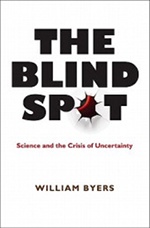
by William Byers
—Reviewed by James Romoser

William Byers opens his dense and detailed book on the philosophy of science with a provocative claim: Many of the most serious problems afflicting contemporary society have their roots in a fundamental misunderstanding of how science works. This misunderstanding is “the crisis of uncertainty” – the hyper-rational (yet impossible) expectation that science or mathematics can provide perfect knowledge and control over the world.
Take, for instance, the meltdown on Wall Street that helped throw the world into recession. That crisis can be traced to the failure of complicated numerical algorithms introduced by highly-trained quantitative analysts, or “quants.” In the chaotic world of investing, “nothing sells so well as the ‘sure thing,’ Byers writes in The Blind Spot: Science and the Crisis of Uncertainty.
The financial devices pushed by the “quants” were not well understood, but they carried the air of scientific objectivity, precision and predictability. As Byers recounts, “People convinced themselves that the risks were not that great, that these new mathematical tools would ensure that money could be made no matter whether the market went up or down.”
On Wall Street, the over-reliance on scientific certainty was famously disastrous, and Byers contends that a similar over-reliance is commonplace in our culture. Many laypeople believe that the purpose, and inevitable outcome, of scientific activity is to uncover some objective certainty, whether about the origin of the universe, the nature of the electron or the tumult of the stock market. But Byers argues that, in fact, “absolute certainty is illusory and that the human need for certainty has often been abused with noxious consequences.”
Unfortunately, Byers, a retired professor of statistics and mathematics, spends too little time addressing these “noxious consequences” or how we might mitigate them. Instead, his book is packed with examples of brilliant men grappling with the intrinsic ambiguities in all sorts of scientific and mathematical problems.
Scientists have been coming to grips with impenetrable uncertainty for millennia. The ancient Greeks could not conceive of the concept of zero or the square root of two. In the 20th century, quantum physics showed that it is impossible, even in principle, to simultaneously measure the speed and position of a particle. And Byers convincingly demonstrates just how deeply the current of uncertainty ripples throughout all of modern science.
Some of his examples are fascinating, as when he discusses the ambiguity inherent in Einstein’s famous E = mc2, which says that all mass is energy and all energy is mass. Others are highly arcane, as when he details certain problems in mathematics that are “undecidable” – that is, problems “for which it is impossible to construct a single algorithm or set of formal rules that will invariably lead to a correct yes-or-no answer.”
For the non-academic reader, the best parts of The Blind Spot are when Byers considers the broader implications of his thesis. His discussion of the financial meltdown is one of those parts, and it is powerful evidence for his contention that the arrogant quest for certainty can create a dangerous misapplication of the scientific method. But oddly, he devotes only three pages to the subject.
And despite his urgent declaration in his preface that “modern civilization is in crisis!”, Byers never elaborates on how his way of thinking about science can help us, as a practical matter, navigate the crises of modern times. The closest he comes is on the very last page of his book, with a throwaway mention of global warming in which he asserts that certain proof of human-caused climate change is impossible. The best we can do, Byers says, is to determine “whether there is a strong likelihood that global warming exists and that human activity is contributing to it.”
That may be true, but it’d be nice to hear more about how the Byers philosophy – which embraces ambiguity and inherent paradox – would respond to the (overwhelming, if not “certain”) evidence of a global climate crisis, not to mention other areas in which science and public policy frequently intersect, like bioengineering, epidemiology, space exploration or the health care system.
Byers, preferring to dwell on abstract mathematics and on a conceptual discussion of the philosophy of science, leaves these areas untouched. Still, despite the omissions, The Blind Spot is valuable because it proposes an approach to science based not on power or control, but on creativity and wonder. And it reminds us of a humbling yet thrilling truth: No matter how precise our microscopes get, and no matter how deep we peer into the cosmos, there will always be a part of reality that we are not able to see.
Excerpt: Now certainty is so attractive that many people think that mathematics and science involve the search for a kind of absolute certainty, which is often what is meant when we talk about the “truth.” I believe that the certainty that accompanies acts of creativity was so seductive that it was isolated from creativity as a value in its own right – for many it was the value. Logic, proof, and deductive thinking – instead of being seen as add-ons to acts of creativity – came to be seen as ends in themselves. This was the birth of the worldview that came to dominate our culture – the search for absolute certainty, absolute truth, a theory of everything. Certainty, considered as a basic drive of our civilization, is the attempt to replace the contingency of life with an ordered, static, and objective world that would not require further acts of creativity because everything was not only pinned down, but even algorithmic.
Buy the book: Skylight Books, Powell’s, Amazon
James Romoser is a freelance writer in Washington, D.C.
*Photo courtesy of nicubunu.photo.




Send A Letter To the Editors